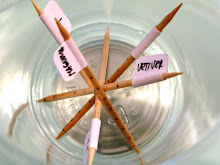Odor intensity of essential oils and aromatic compounds vary greatly. For example, it will take over 100 drops of Sandalwood Oil to balance just 1 drop of Cistus (and this is even without taking into account effect of Odor Slope which will be discussed later).
- Its own Odor Strength is in the middle of the spectrum;
- This is a distinct BASE note and it will last on a blotter for a long time without much change to perceived Odor Intensity;
- It has a very distinct Odor, which can be described as deep smoky-dry, earthy-woody and slightly sweet. It is easier to recognize Vetiver in simple combinations.
- And finally, this is a rather common and affordable ingredient. Most supplies will have Vetiver in their stock.
10% Vetiver Etalon
Please mark the first toothpick in a special way and dip it 5mm (1/4 inch) into undiluted Vetiver oil – this will represent Odor Intensity of a single drop of a 10% Vetiver dilution (5 cm / 2 inches of a toothpick absorbs 1 drop of an oil).
Note: majority of oils should not be smelled directly from bottles as it may temporarily reduce your ability to perceive odors.
Studying Your Aroma Library - Testing Oils
- Dip new toothpick 5mm deep into the oil and compare it to 10% Vetiver Etalon. If oils appear to be of similar intensity, it would mean that 10% Vetiver = 10% Tested Oil
- If Tested Oil appeared to be weaker, then try to dip it 10mm and compare results again. Repeat the process until similar intensity has been achieved. Every 5mm represent 10%. So, if Tested Oil produced similar intensity at 30mm dip, that means that: 10% Vetiver = 30% Tested Oil
- If Tested Oil is weaker, you may try to dip new toothpick less than 5mm, but that process becomes a little tricky. I would recommend making a 10% dilution of the Tested Oil using Perfume Alcohol. Then each 5mm will correspond to 1% of the Tested Oil. For example, if 10mm dip of a 10% dilution of the oil produced a similar Odor Strength to the Etalon that means that: 10% Vetiver = 2% Tested Oil.
- And if 10% dilution is still too strong to provide precise results, continue with further diluting the oil down to 1% and do the testing. Some oils such as Oakmoss (EOS), Leather (TGSC), Rose De Mai (EOS), Violet Leaf (E7) and others require 0.1% dilutions not to overpower 10% Vetiver Etalon!
I have summarized results of my tests of my own library of essential oils and aromatic compounds in AromaLibrary.com Clearly, this is an ongoing process as rather often I would review my own findings at a later date and I would suggest to consider data regarding Odor Strength only as a guideline for your own discoveries.
Ok, and here is the main treasure: continuously updated table of Essential Oils and Aromatic Compounds in Google Spreadsheet format.


No comments:
Post a Comment